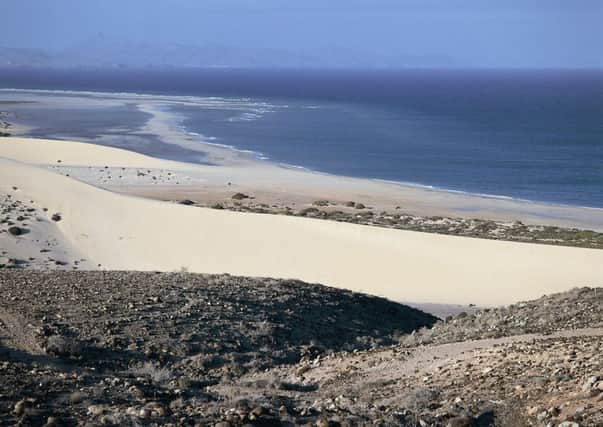Travel review: Fuerteventura


The wind is regular though relenting (apart from in September when it lulls) and permeating but not piercing. But there’s also proper heat, not just warmth. With only a week to have a break, you don’t want to fly for eight hours or suffer jet lag. It takes only four hours from London to Puerto del Rosario, the capital and airport of Fuerteventura.
Throughout the island there’s a fabulous sense of expanse, both from the small population and the wide landscape. There’s a real chance for peace and quiet with remote spots to indulge in for solace and solitude. I slept both in view of and to the sound of, the sea. Perfect deep sleep!
Advertisement
Hide AdAdvertisement
Hide AdThis is island of bleak contrasts. The desert consequences of volcanic eruption certainly make you appreciate vegetation where you can find it. And then there are the cacti with their own distinctive shapes and character. It’s a great place to get a sense of real desert, of the Sahara even (which is on the same parallel) as camels lope in their strides across the road.
The colours are relaxing and wonderfully harmonious with the blue sky and beige sand tones, the occasional green shrub, white clouds and the teal and aqua shades of the sea. The sea provides a respite from the sweeping but arid land, and the coastline with its curvaceous humps and agitated waves resembles Cornwall at times.
For culture seekers there’s Vallebrón, a hamlet of a hundred or so inhabitants south of the quiet, administrative centre that is La Oliva. It’s set in a broad-shaped valley sandwiched between two mountainous headlands. And then there’s Betancuria, the former capital that retains a real sense of history with its ancient doorways and 17th century church. There’s even a salt museum. To get a feel in advance of arriving, I recommend the novel Sandy Shores by Kris Moller. It’s a ripping yarn involving a pact with the devil between a thief and a skipper all set in Fuerteventura.
For kite surfers this has become a top spot. They enjoy their guaranteed wind predominantly on the east coast while board surfers flock to the west coast. El Cotillo is a surfing town full of cool bars and restaurants for the dude community, with Vaca Azul a special place to eat. The beaches and lagoons lie prostrate before the aggressive, agitated sea and its black wet-suited bobbing community. Golfers come from afar for their one spot of greenery.
Advertisement
Hide AdAdvertisement
Hide AdAs for wildlife, there are noticeably few dogs or cats. In the north there are seabirds (especially Gorriones seagulls that have arrived from Africa). In the south there are barbary ground squirrels and goats, of which there are more than 30 different types across the island. They scavenge a meal from the meanest terrain, from thorny bushes in rocky outcrops to scrubby foliage among the sand dunes.
The three hundred odd camels came over with the Normans in 1405 and are both at large as well as for tourist rides. Soon there will be camel milk available. It has much protein but 40 per cent less cholesterol than cow’s milk and a high mineral and vitamin C content.
I stayed first at the Gran Hotel Atlantis Bahia Real (atlantisbahiareal.com). It’s set on a white-sand beach bordering the Corralejo dunes and looks across at the Isla de Lobos and Lanzarote beyond. My room was right on the beachfront. The decor and style is an intriguing mix of Moroccan and Andalucian in the Neo-Mudejar style. Birds flutter around the tropical garden set within the interior courtyards and patios that surround the swimming pools. There’s a new extension to the east with a pale yellow facade that will cater for VIP guests. It’s special to be able to walk straight out, past the hotel beach and onto the famous dunes. They are inspirational though marred, especially given their national park status, by two hotels planted in the middle, the trade-off for the owner also of the Isla de Lobos in allowing ramblers access to the island.
My favourite beach was one at the southern tip of the island called the Playa de Cofete, which required going off the tarmac and into the unknown. It was eight miles along a dirt track, then single-track hairpin bends before I reached a summit with a truly stunning view across a series of ridges all angling down towards the long deserted beach. Only a sailing boat in the distance showed any sign of human intervention.
Advertisement
Hide AdAdvertisement
Hide AdWhile neighbouring Lanzarote has a certain conformity of design as a result of the great César Manrique with his white-washed walls and green doors, here things can be more freestyle. And I was lucky enough to stay next at the Occidental Jandia Royal Level Suite (www.barcelo.com/en-gb/hotels/spain/canary-islands/fuerteventura/occidental-jandia-royal-level). Here at this adult-only section of a large resort, I was made to feel not just welcome but rather special as my black wristband allowed me to access all areas, including a ‘premium’ breakfast and dinner restaurant. The food was excellent with fresh orange juice and barbecues and every meal cooked before my very eyes. There’s a buffet full of fruit and vegetables but there are also treats.
I strongly recommend Fuerteventura strong winds and all.
GETTING THERE
Classic Collection Holidays (0800 047 1064, classic-collection.co.uk) offers a two-centre holiday of three nights at Gran Hotel Atlantis Bahia Real on a bed & breakfast basis and three nights at Occidental Jandia Royal Level Suite on an all-inclusive basis from £1,279 per person. Price based on two adults sharing and includes return flights from London Gatwick to Fuerteventura (flights available from up to 16 UK airports) and all private transfers.
Adam had support from gatwickexpress.com and chepstowcars.com